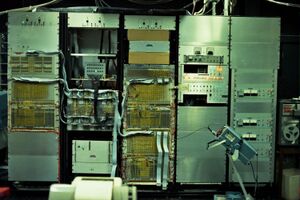BCC 500
The BCC 500 was a computer made by the Berkeley Computer Corporation, from an initial design at Project GENIE. When the company went bankrupt in 1971, the prototype was sold to University of Hawaii. After two years of refurbishment it was successfully deployed as an ARPANET host until 1980. It was also the hub of the ALOHA network which inspired Ethernet.
The computer consisted of six independent microcoded processors, having a 24-bit word width, 18-bit addressing, and access to a shared memory. The microcode implemented an instruction set with a 6-bit opcode and 18-bit address field, as well as a subset of the 940 instruction set. Two of the processors had expanded hardware capabilities and ran user code. The other four were each responsible for implementing their own part of the operating system; part in microcode and part in macrocode.
At BCC, an IBM 360/30 acted as a front end, handling tape drives, card readers, and printers. This was replaced by an HP2100A at Hawaii. A PDP-11/10 running ELF connected to the ARPANET.
See also
External links
- BCC - documentation at Bitsavers
- Aloha BCC-500 - more
- Files from the BCC 500 computer at University of Hawaii - extracted from the above
- BCC 500 documents - from Butler Lampson
- Extracted files
- The BCC 500 Computing System: An Introduction and Overview
- PFS Reference Manual - '"PFS" probably stands for 'Preliminary File System'
- Some Remarks on a Large New Time-Sharing System
- Dynamic protection structures
